Ichneumonidae
| Ichneumon wasps | |
|---|---|
| | |
| Diphyus sp., Rhône (France) | |
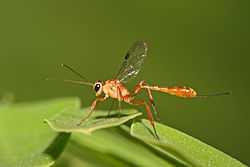 | |
| Cremastinae, (Tanzania) | |
| Scientific classification | |
| Kingdom: | Animalia |
| Phylum: | Arthropoda |
| Class: | Insecta |
| Order: | Hymenoptera |
| Suborder: | Apocrita |
| Superfamily: | Ichneumonoidea |
| Family: | Ichneumonidae Latreille, 1802 |
| Subfamilies | |
|
Acaenitinae | |
The Ichneumonidae are a family within the order Hymenoptera. Insects in this family are commonly called ichneumon wasps. Less exact terms are ichneumon flies (they are not closely related to true flies), or scorpion wasps due to the extreme lengthening and curving of the abdomen (scorpions are arachnids). Simply but ambiguously, these insects are commonly called "ichneumons", which is also a term for the Egyptian mongoose (Herpestes ichneumon); ichneumonids is often encountered as a less ambiguous alternative. Ichneumon wasps are important parasitoids of other insects, including the social wasp Vespula acadica. Common hosts are larvae and pupae of Coleoptera, Hymenoptera, and Lepidoptera.
Over 60,000 species occur worldwide, with about 3,000 in North America - more than any other Hymenoptera family. The distribution of Ichneumonidae has traditionally been one of the most notable exceptions to the common latitudinal gradient in species diversity, since the family is thought to be at its most species rich in high latitudes instead of the tropics.[1] This traditional view has recently been questioned after the discovery of numerous new tropical species.[2][3]
Charles Darwin discussed the Ichneumonidae with regard to his views on religion; see Darwin and the Ichneumonidae, below.
Description
Ichneumon wasps differ from typical, aculeate wasps, which sting in defense and do not pass their eggs along the stinger (Aculeata: Vespoidea and Apoidea), in that the antennae have more segments; typically 16 or more, whereas the others have 13 or fewer. Female ichneumon wasps sometimes have an ovipositor longer than their body. Ovipositors and stingers are homologous structures; Ichneumons generally inject venom along with the egg, but only larger species, with relatively shorter ovipositors, use the ovipositor as a stinger in defense. Stingers in aculeate Hymenoptera - which like Ichneumonidae belong to the Apocrita - are used exclusively for defense; they cannot be used as egg-laying equipment. Males do not possess stingers or ovipositors in either lineage.
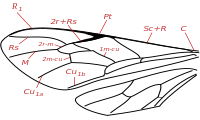

Distinction from Braconidae
Ichneumonidae are distinguished from their sister group Braconidae by these character combinations. Vein 2m-cu of the forewing is present in 95% of Ichneumonidae - it is absent in Braconidae; vein 1/Rs+M is absent in all Ichneumonidae- it is present in 85% of Braconidae. Vein 1R-M of the hind wing is opposite or apical to the separation of R1 and Rs in Ichneumonidae- it is basal in Braconidae. About 90% of Ichneumonidae have a flexible suture between metasomal terga 2 and 3 -these tergites are fused in Braconidae (though the suture is secondarily flexible in Aphidiinae).[4]
Reproduction and oviposition
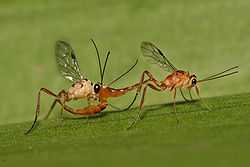
Some species of ichneumon wasps lay their eggs in the ground, but most inject them directly into a host's body, typically into a larva or pupa. Host information has been notably summed up by J.F. Aubert, et al.[5]
In some of the largest species, namely from the genera Megarhyssa and Rhyssa, both sexes will wander over the surfaces of logs and tree trunks, tapping with their antennae. Each sex does so for a different reason; females are searching for the scent of wood-boring larvae of the horntail wasps (hymenopteran family Siricidae) upon which to lay eggs; males are searching for emerging females with which to mate.
Upon sensing the vibrations emitted by a wood-boring host, the female wasp will drill her ovipositor into the substrate until it reaches the cavity wherein lies the host. She then injects an egg through the hollow tube into the body cavity. There, the egg will hatch and the resulting larva will devour its host before emergence. How a female is able to drill with her ovipositor into solid wood is still somewhat of a mystery, though metal (ionized manganese or zinc) is found in the extreme tip of some species' ovipositors. The adult insect, following pupation, is faced with the problem of extricating itself from tunnels of its host. Fortunately, the high metal concentrations are not limited to the female's ovipositor, as the mandibles of the adult are also hardened with metals and it uses these to chew itself out of the wood.[6]
The process of oviposition in Dolichomitus imperator
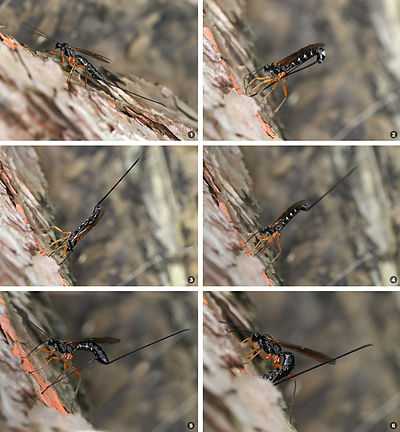
- Tapping with her antennae, the wasp detects and localizes scent and vibrations that indicate a host is present.
- With the longer ovipositor, the wasp drills a hole through the bark.
- The wasp inserts the ovipositor into the cavity which contains the host larva.
- Making corrections.
- Depositing her eggs.
Taxonomy and systematics
The Ichneumonidae are the subject of ongoing taxonomical difficulty. About as diverse as the true weevils (Curculionidae), there are numerous small, inconspicuous and hard-to-identify ichneumon wasps. The sheer diversity means DNA sequence data are only available for a tiny fraction of the species, and detailed cladistic studies require major-scale computing capacity.
Consequently, the phylogeny and systematics of the ichneumon wasps are not definitely resolved. Several prominent authors - such as H. T. Townes and J. Oehlke - have gone as far as to publish major reviews that defy the International Code of Zoological Nomenclature.[7]
Regardless, a number of seminal works exist, including the extensive study and the synonymic catalogue by Townes, but also treatments by other entomologists, namely J. F. Aubert, whose notable collection of ichneumon wasps is in Lausanne.[8]
Subfamilies
The list presented here follows the suggestion of David Wahl of the American Entomological Institute.[9] It will be updated as necessary, as new research refines the interrelationships of the ichneumon wasps.
The subfamilies are not listed in a taxonomic or phylogenetic sequence, as the relationships between the groups are not yet resolved to a degree to render any such arrangement reliable:[9]
- Acaenitinae
- Agriotypinae
- Adelognathinae
- Anomaloninae (= Anomalinae)
- Banchinae
- Brachycyrtinae (sometimes included in Labiinae)
- Campopleginae (= Porizontinae)
- Collyriinae
- Cremastinae
- Cryptinae (= Gelinae, Hemitelinae, Phygadeuontinae)
- Ctenopelmatinae (= Scolobatinae)
- Cylloceriinae (= Oxytorinae, sometimes included in Microleptinae)
- Diacritinae (sometimes included in Pimplinae)
- Diplazontinae
- Eucerotinae (sometimes included in Tryphoninae)
- Ichneumoninae
- Labeninae (= Labiinae)
- Labenopimplinae
- Lycorininae (sometimes included in Banchinae)
- Mesochorinae
- Metopiinae
- Microleptinae
- Neorhacodinae (sometimes included in Banchinae)
- Ophioninae
- Orthocentrinae (sometimes included in Microleptinae)
- Orthopelmatinae
- Oxytorinae
- Paxylommatinae (sometimes not placed in Ichneumonidae at all)
- Pedunculinae
- Poemeniinae
- Phrudinae
- Pimplinae (= Ephialtinae)
- Poemeniinae (sometimes included in Pimplinae)
- Rhyssinae (sometimes included in Pimplinae)
- Stilbopinae (sometimes included in Banchinae)
- Tatogastrinae (sometimes included in Microleptinae or Oxytorinae)
- Tersilochinae
- Tryphoninae
- Xoridinae
Morphology
-
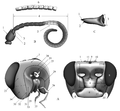
Morphology of head and its processes: (А) head capsule; (В) antenna; (С) mandible[1]
-

Morphology of thorax (D)[1]
-

Morphology of abdomen and processes of thorax: (E) front wing; (F) leg III; (G) abdomen of female[1]
Famous ichneumonologists
Famous ichneumonologists include:
- Carl Gustav Alexander Brischke
- Peter Cameron
- Arnold Förster
- Johann Ludwig Christian Gravenhorst
- Alexander Henry Haliday
- August Emil Holmgren
- Joseph Kriechbaumer
- Thomas Ansell Marshall
- Constantin Wesmael
Darwin and the Ichneumonidae
The grisliness and apparent cruelty (at least, from a human perspective) of Ichneumonidae larval cannibalism troubled philosophers, naturalists, and theologians in the 19th century, who found the practice inconsistent with the notion of a world created by a loving and benevolent God.[10] Charles Darwin found the example of the Ichneumonidae so troubling, it contributed to his increasing doubts about the nature and existence of a Creator. In an 1860 letter to the American naturalist Asa Gray, Darwin wrote:
I own that I cannot see as plainly as others do, and as I should wish to do, evidence of design and beneficence on all sides of us. There seems to me too much misery in the world. I cannot persuade myself that a beneficent and omnipotent God would have designedly created the Ichneumonidae with the express intention of their feeding within the living bodies of Caterpillars, or that a cat should play with mice.[11]
See also
Footnotes
- ↑ Sime, K. R.; Brower, A. V. Z. (1998). "Explaining the latitudinal gradient anomaly in ichneumonid species richness: Evidence from butterflies". Journal of Animal Ecology 67 (3): 387. doi:10.1046/j.1365-2656.1998.00198.x. JSTOR 2647379.
- ↑ Veijalainen, A.; Wahlberg, N.; Broad, G. R.; Erwin, T. L.; Longino, J. T.; Saaksjarvi, I. E. (2012). "Unprecedented ichneumonid parasitoid wasp diversity in tropical forests". Proceedings of the Royal Society B: Biological Sciences 279 (1748): 4694. doi:10.1098/rspb.2012.1664.
- ↑ Quicke, D. L. J. (2012). "We Know Too Little about Parasitoid Wasp Distributions to Draw Any Conclusions about Latitudinal Trends in Species Richness, Body Size and Biology". PLoS ONE 7 (2): e32101. doi:10.1371/journal.pone.0032101.
- ↑ Sharkey, M.J. (1993), Family Braconidae, pp. 362-394. In: Goulet, H. and J. Huber (eds.). Hymenoptera of the world, an identification guide to families, Agriculture Canada Research Branch Monograph No. 1894E.
- ↑ Aubert (1969, 1978, 2000), Perkins (1959, 1960), Townes et al. (1965)
- ↑ Ross Piper (2007), Extraordinary Animals: An Encyclopedia of Curious and Unusual Animals, Greenwood Press
- ↑ Oehlke (1966, 1967), Townes (1969abc, 1971)
- ↑ Aubert (1969, 1978, 2000), Gauld (1976), Perkins (1959, 1960), Townes (1969abc, 1971), Townes et al. (1965)
- ↑ 9.0 9.1 Wahl (1999)
- ↑ "Nonmoral Nature". Retrieved 2011-04-05.
- ↑ "Letter 2814 — Darwin, C. R. to Gray, Asa, 22 May [1860]". Retrieved 2011-04-05.
References
- Aubert, J. F. (1969): Les Ichneumonides ouest-palearctiques et leurs hotes 1. Pimplinae, Xoridinae, Acaenitinae ["The Western Palearctic ichneumon wasps and their hosts. 1. Pimplinae, Xoridinae, Acaenitinae"]. Laboratoire d'Evolution des Etres Organises, Paris. [in French]
- Aubert, J. F. (1978): Les Ichneumonides ouest-palearctiques et leurs hotes 2. Banchinae et Suppl. aux Pimplinae ["The Western Palearctic ichneumon wasps and their hosts. 2. Banchinae and supplement to the Pimplinae"]. Laboratoire d'Evolution des Etres Organises, Paris & EDIFAT-OPIDA, Echauffour. [in French]
- Aubert, J. F. (2000): Les ichneumonides oeust-palearctiques et leurs hotes. 3. Scolobatinae (=Ctenopelmatinae) et suppl. aux volumes precedents [The West Palaearctic ichneumonids and their hosts. 3. Scolobatinae (= Ctenopelmatinae) and supplements to preceding volumes]. Litterae Zoologicae 5: 1-310. [French with English abstract]
- Fitton, M. G. & Gauld, I. D. (1976): The family-group names of the Ichneumonidae (excluding Ichneumoninae) (Hymenoptera). Systematic Entomology 1: 247-258.
- Fitton, M. G. & Gauld, I. D. (1978): Further notes on family-group names of Ichneumonidae (Hymenoptera). Systematic Entomology 3: 245-247.
- Gauld, I. D. (1976): The classification of the Anomaloninae (Hymenoptera: Ichneumonidae). Bulletin of the British Museum of Natural History (Entomology) 33: 1-135.
- Oehlke J. (1966): Die westpaläarktische Arte der Tribus Poemeniini (Hymenoptera, Ichneumonidae) ["The Western Palearctic species of the tribe Poemeniini"]. Beiträge zur Entomologie 15: 881-892.
- Oehlke J. (1967): Westpaläarktische Ichneumonidae 1, Ephialtinae. Hymenopterorum Catalogus (new edition) 2: 1-49.
- Perkins, J. F. (1959): Ichneumonidae, key to subfamilies and Ichneumoninae – 1. Handbook for the Identification of British Insects 7(part 2ai): 1–116.
- Perkins, J. F. (1960): Hymenoptera: Ichneumonoidea: Ichneumonidae, subfamilies Ichneumoninae 2, Alomyinae, Agriotypinae and Lycorininae. Handbook for the Identification of British Insects 7(part 2aii): 1–96.
- Tereshkin, A. (2009): Illustrated key to the tribes of subfamilia Ichneumoninae and genera of the tribe Platylabini of world fauna (Hymenoptera, Ichneumonidae). Linzer biol. Beitr. 41/2: 1317-1608. PDF
- Townes, H. T. (1969a): Genera of Ichneumonidae, Part 1 (Ephialtinae, Tryphoninae, Labiinae, Adelognathinae, Xoridinae, Agriotypinae). Memoirs of the American Entomological Institute 11: 1-300.
- Townes, H. T. (1969b): Genera of Ichneumonidae, Part 2 (Gelinae). Memoirs of the American Entomological Institute 12: 1-537.
- Townes, H. T. (1969c): Genera of Ichneumonidae, Part 3 (Lycorininae, Banchinae, Scolobatinae, Porizontinae). Memoirs of the American Entomological Institute 13: 1-307.
- Townes, H. T. (1971): Genera of Ichneumonidae, Part 4 (Cremastinae, Phrudinae, Tersilochinae, Ophioninae, Mesochorinae, Metopiinae, Anomalinae, Acaenitinae, Microleptinae, Orthopelmatinae, Collyriinae, Orthocentrinae, Diplazontinae). Memoirs of the American Entomological Institute 17: 1-372.
- Townes, H. T. ; Momoi, S. A. & Townes, M. (1965): Catalogue and Reclassification of Eastern Palearctic Ichneumonidae Memoirs of the American Entomological Institute 5: 1-661 pages.
- Wahl, David (1999): Classification and Systematics of the Ichneumonidae (Hymenoptera). Version of 1999-JUL-19. Retrieved 2008-JUN-18.
External links
| Wikimedia Commons has media related to Ichneumonidae. |
| Wikispecies has information related to: Ichneumonidae |
Description
- Long Family Description Many illustrations from John Curtis British Entomology
- Short Family Description
Distribution
Taxonomy and Systematics
- Ichneumonidae:Classification of afrotropical ichneumonid wasps. Extensive use of images.
- Key to Subfamilies found in Britain and Ireland Extensive use of images.
- Aramel Overview. In French.
Other
- Important Systematic Literature
- Family Ichneumonidae at EOL Comprehensive image database
- Reference large-format photos of 15 different species of Ichneumonidae
- Photo Essay: Giant Ichneumon Wasps Ovipositing
- Reference Photos: Giant Ichneumon Wasps - Male Megarhyssa sp.
- Ichneumonidae as Biological Control Agents of Pests with Bibliography long download pdf
- Ichneumonid Types in Entomological Institute of Hokkaido University In Japanese but a pulldown menu of Subfamilies by clicking bottom box.
- Ichneumonidae Database In Korean but with images and type repositories in English.
- Diagnostic features of subfamilies
- Key to subfamilies in Spanish and not all the families, but good photos.
- Diadegma insulare on the University of Florida / Institute of Food and Agricultural Sciences Featured Creatures website
- Taiwan Digital Insects 401 species imaged.
- Galerie Insecte French Images by subfamily and genus.
- Hymis De Images 47 on 6 pages of authority (expert) named Ichneumonidae. Ongoing.
- W.Rutkies Images. Authority id.
- Camille Thirion Image Gallery
- Hymatol Subfamily Key Powerpoint pdf Excellent photos, figures and text. Note that it is 300MB in size.
- A.Tereshkin: Information about different species of Ichneumonidae (Hymenoptera), first of all Ichneumoninae Stenopneusticae, collected by author (taxonomic, faunistic and biological data, original images, methods of Ichneumonidae collecting etc.) and PDF collection of some G. Heinrich’s articles.
| ||||||||||||||||||||||||||||||||||||||||||||||||||||||||||||||||||||||||||||||||||||||||||||||||||||||||||